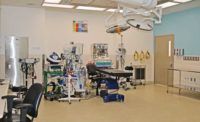Primary Children’s Hospital Hybrid Operating Room
Salt Lake City, Utah
Best Small Project
Submitted By: Jacobsen Construction Co.
Region: ENR Mountain States
Owner: Primary Children’s Hospital
Lead Design Firm: NJRA Architects
General Contractor: Jacobsen Construction Co.
Structural Engineer: Reaveley Engineers + Associates
Mechanical Engineer: VBFA
Electrical Engineer: BNA Consulting
Subcontractors: A&D Fire Sprinklers Inc.; Apache Industrial Services Inc.; Architectural Building Supply LLC; Architectural Components Inc.; DAW Construction Group LLC; Glassey Steel Works; Grow Painting Inc.; HC West LLC; Healthcare Technology Corp.; KOH Mechanical; Millcreek Tile & Stone LLC; Mitchell Acoustics Inc.; Mollerup Glass Co.; Quirk Inc.; Stainless Steel Specialties LLC; Stonhard; Taylor Electric Inc.; Western Sheet Metal
Situated centrally between 13 active operating rooms, this project’s work site proved to be its most complex challenge, says Sourabh Sinha, project manager at NJRA Architects. “Mitigating construction noise, dust and possible infection is of utmost importance in an environment like operating rooms,” he says. The solution was incising a sealed tunnel corridor running from the hospital’s exterior directly to the work site. Without a usable exit, workers removed a section of the exterior wall to create the endpoint from scratch. Tools and equipment coming into this sterile environment had to first be specially cleaned and covered. Workers wore head-to-toe Tyvek “bunny suits.”
Relocating the surgical gas lines to make room for that tunnel required extensive pre-planning. Rapidly relocated during hospital off-hours, correct pipe placement was still verified with several layers of redundancy. “If we were to run nitrous oxide in an oxygen line, just think of the outcome,” says Scott Sabin, project manager at Jacobsen Construction.
The operating room was built directly above the hospital’s histology lab. Steel reinforcement was added to the ceiling of the lab to bear the weight of the equipment above. The team constructed dance floor scaffolding just 12 in. below the ceiling along with protective netting to keep the lab in use and sterile.





